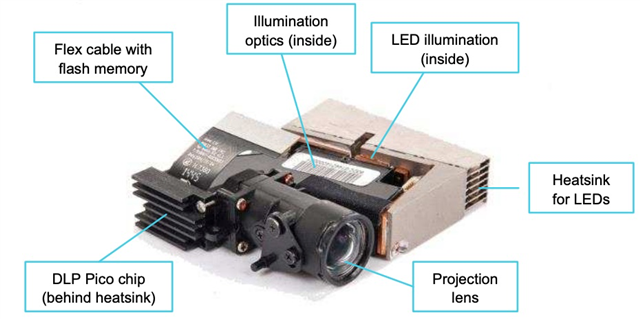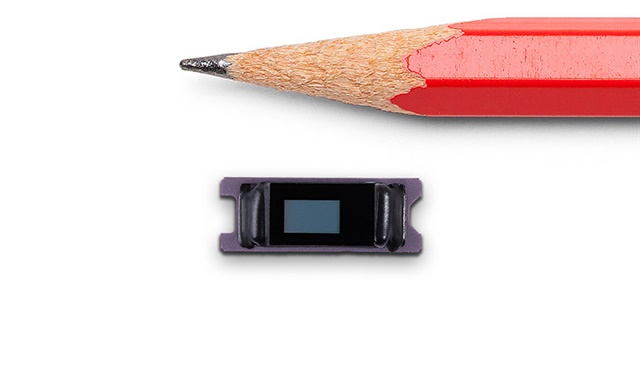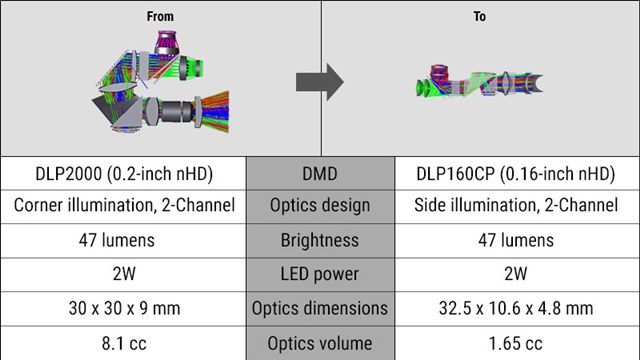SSZT124 October 2021 DLP160AP , DLP160CP , DLP2000
You're integrating an on-demand projection display into a next-generation appliance, autonomous robot or augmented reality (AR) glasses. Or maybe you're designing a smartphone accessory that can beam fitness and sleep stats onto your nightstand. What is the smallest DLP® projection solution? How does the DLP digital micromirror device (DMD) design impact the projection module size? Can a tiny projector still produce a bright, clear and crisp image? In this article, I'll answer those questions and dive into TI's thought process for designing the 0.16-inch DLP160CP DMD.
Let's look first at the DMD itself and then the impact it has on the size of the projection module.
The previous-generation version of this DMD, the 0.2-inch (nHD) DLP2000, has an array of 640 × 360 micromirrors, each with a 7.6-µm pitch. The new DMD incorporates the newer 5.4-µm tilt-and-roll pixel (TRP) technology, reducing the diagonal of the mirror array 20%, to 0.16 inches. In effect, this reduces the mirror array area by 49% which significantly reduces the optical module size – the core subsystem of a TI DLP® Pico™ display system. See Figure 1.
 Figure 1 Example Optical Module
Figure 1 Example Optical ModuleAchieving an even greater size reduction required an evaluation of how the DMD design affects the optical module architecture. Our product marketing team asked our optics team to design the smallest possible optical module using these parameters:
- The DLP160CP, shown in Figure 2.
- Side-illuminated optics.
- Well-matched, existing LEDs.
- Higher brightness and efficiency than the DLP2000.
 Figure 2 The 0.16-Inch DLP160CP
DMD
Figure 2 The 0.16-Inch DLP160CP
DMDOptics Design and Architecture Philosophy
The direction at which light enters the DMD can have a significant effect on the total system volume. Designing the 0.16-inch DLP160CP DMD to be side-illuminated enables an inline optical architecture that reduces size significantly – drastically reducing the height and width of the projection module – compared to the corner-illuminated 0.2-inch DLP2000 DMD, which requires a U-shaped optical design.
Our product marketing and optics teams also worked closely with LED suppliers (OSRAM and Luminus) to use LEDs with a best matched etendue (the geometric property of light that quantifies the throughput capability of the optical system) to the DLP160CP. A closely matched etendue translates to optimized brightness and power efficiency, and a more compact module. Multiple LED options are available today that are well matched with the DLP160CP DMD.
The resulting 0.16-inch nHD DMD optical module was 80% smaller than the smallest 0.2-inch DLP2000-based optical module, and 50% smaller than the 0.2-inch DLP2010-based optical module (Figure 3). This helps significantly when you're incorporating a projection module into a small product or a system with limited real estate for a display. The DLP160CP enables you to fit an efficient projection module into extremely small spaces without compromising the form factor and size of your product.
 Figure 3 Optical Module Comparison
Figure 3 Optical Module ComparisonApplications
The DLP160CP DMD drastically reduces optical module size while maintaining bright, crisp and reliable images. With up to 100 lumens of brightness, the DLP160CP has enough brightness versatility for you to integrate a tiny projector into applications such as smart informational displays, appliances, toys, AR glasses and ultracompact pico projectors, as shown in Figure 4.
 Figure 4 Example Applications
Figure 4 Example ApplicationsConclusion
The new 0.16-inch DLP160CP DMD is a good fit for any application that requires an extremely compact projection system to create bright and crisp video or informational images on virtually any surface. Now you can seamlessly design that on-demand projection display into your next-generation Internet of Things appliance, autonomous robot or AR glasses.
Additional Resources
- View the DLP160CP DMD data sheet.
- Download the DLP160CP (0.16 nHD) optical reference design.
- Download the DLP160CP AR glasses eyepiece optical reference design.
- To learn more about optical module design considerations, check out the application note, "TI DLP Pico System Design: Optical Module Specifications."
- Read the application report, "Getting Started with TI DLP Display Technology."